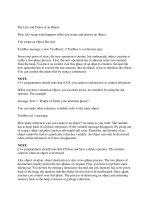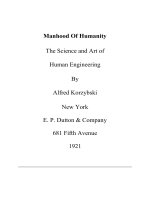andy warhol the life and art of the prince of pop 1775
Bạn đang xem bản rút gọn của tài liệu. Xem và tải ngay bản đầy đủ của tài liệu tại đây (42.88 KB, 3 trang )
Andy Warhol: The Life and Art of the Prince of Pop
Andy Warhol created the most sensational and often controversial art of the 1960's. He
appropriated images that Americans knew and loved like Campbell's soup cans and
Coca-Cola and transformed them into radical and enduring works of art. Andy's art did not give
us answers; instead, it raised questions. He gave us a shocking look at what constitutes who we
are. In grasping the essence of Pop Art, Warhol's work is completely about the spirit of culture in
modern society.
Andrew Warhola was born in Pittsburgh, Pennsylvania in 1928, to a poverty-stricken immigrant
family. Having no money to buy toys, Andy's mother encouraged him and his two brothers to
draw. Little Andrew took to it immediately, impressing his family with his pictures. His father, a
factory worker, had only enough money to send one child to college. He began to save his pennies
so that Andrew could be the first of the Warhola's to attend college.
At age eight, Andrew was diagnosed with a nervous disorder called St. Vitus's Dance, which made
his limbs shake uncontrollably, and turned his skin ghost-white. Later in life, it also made his hair
fall out (hence the white wigs). He was ridiculed in school, and became a loner, always opting to
watch, rather than partake in fun activities.
"In the future, everyone will be world famous for 15 minutes." -Andy Warhol
Andy's fame as an artist lasted longer than fifteen minutes. It began at Carnegie University in
Pittsburgh, where he learned valuable lessons in getting attention. He was a shy person and loved
to observe people. He studied them from the sidelines, painting portraits of his classmates, which
quickly earned him an entourage of friends. It was also in college that he submitted a painting to
an art contest; it was a grotesque image of a man picking his nose. Although the painting was
immediately withdrawn from the contest, he hung it on the wall at school, and students flocked to
see it. It was then that he learned that controversy pays.
In 1949 he moved to Manhattan to pursue his lifelong dream of money and fame as a commercial
artist. In less than a week, he landed his first account with Glamour magazine, entitled "Success is
a Job in New York." It was an editorial error in that article that gave him his new name. It
mistakenly appeared as Andy Warhol. He liked it, and decided to keep it.
Throughout the 1950's, Andy worked for several different magazines, and made window displays
for retail stores. He was one of the first artists to understand the importance of marketing and the
media. It served him well, making him one of the highest paid commercial artists in New York.
"Once you got Pop, you could never see a sign the same way again. And once you thought Pop,
you could never see America the same way again." -Andy Warhol, 1980
The 1960's were a prolific decade for Andy Warhol. He was determined to break out of the world
of commercial art, and into the league of fine artists. At the time, the world of fine art was
dominated by Abstract Expressionism, which featured unrecognizable scribbles on a canvas, in an
attempt to convey an emotion. Pop Art was a revolt against Abstract Expressionism, and pop
artists focused on the world outside of themselves. They exploited superficial images of a
prosperous post-war America, and turned them into vibrant, consumer driven art. Andy was one of
the leaders in Pop Art.
In addition to painting, Andy began to silkscreen his art figures. His first images of society's stars
like Marilyn Monroe, Elvis, and Jackie Onassis, were immediate successes. He bought a building
and started "The Factory," with an entourage of artists mass-producing his work. One could buy
them small, medium or large (priced accordingly, of course), or even 100 multiplied on one
canvas.
One cannot help but wonder if Warhol anticipated the highly charged reactions to his choice of
subjects, showing the figures who had touched the lives of the American public, whose real-life
tragedies had stirred the emotions of all those who had "known" them. Whatever his intent, Andy's
dream of fame and riches had come true, as he immediately became as well-known as the stars he
painted.
"If you want to know all about Andy Warhol, just look at the surface of my paintings and films
and me, and there I am. There's nothing behind it." -Andy Warhol, 1987
Although Warhol himself neither offered nor refuted any explanation of his art, it seemed at times
as if he was trying to expose our most hidden sides, and satisfy our secret curiosities. Works such
as Electric Chair (1967), Five Deaths (1962), White Burning Car (1963), all from his "Death and
Disaster" series, were disturbing, yet fascinating at the same time. Electric Chair appeared at the
very moment when Americans were hotly debating the morality of the death penalty. It constitutes
one of the most powerful images in 20th-century American art. Five Deaths depicted people
bloody and dying, trapped
under a wrecked car. Some say the picture reflected society by sending the message: "Here we are,
with our love of money and big beautiful things; and here is what is does to us." White Burning
Car, shows a car in flames, and a dead man hanging from a nearby tree. In the background, there
is a man leisurely walking by, paying no attention to the catastrophe. This work unmistakably
rubbed society's indifference right in their faces. People looked at it in horror, forced to see a part
of themselves they chose not to acknowledge.
"They're experimental films; I call them that because I don't know what I'm doing. I'm interested in
audience reaction to my films " -Andy Warhol, 1967
In 1965, Andy announced his retirement from painting (which he later revoked), in order to
concentrate on filmmaking. His films, like his art, broke all the rules. They did not have a plot or
script, and were often visually unfocused. Two of his most popular films were entitled Sleep, and
Blow Job. Sleep was a five-hour film of his male friend sleeping in the nude. Blow Job depicted
only the face of a man receiving fellatio. Another, Empire, was merely eight ours of the Empire
State Building against a dark sky. One could say that Andy's films were the 1960's version of the
web cam.
During this time, the factory had gotten out of control. Although Andy never took drugs, his
entourage indulged in them. It was a never-ending party of sex, drugs and rock'n'roll. The band he
managed (and formed at the factory), called The Velvet Underground, would often play there. But
in 1968, the party stopped, as someone walked
in that changed Andy's life and art forever.
Valerie Solanis, a groupie from the factory, and the founder and sole member of S.C.U.M.
(Society for Cutting Up Men), walked into Andy's office and shot him three times. The first two
shots missed, but the third was fired point blank into Andy's chest. Andy was pronounced dead at
the hospital, then later revived. He was hospitalized for months, and was forced to wear a painful
corset for the rest of his life. When asked why she did it, Valerie said, "He had too much control
over my life." She also blamed him for losing the only copy of her masterpiece, so eloquently
entitled Up Your Ass.
It was years before Warhol was back in action. He had not recovered mentally from the shooting
and had become paranoid. He shut down the old factory, and purchased a new building, hiring
business-minded men to run it. But the toll of Andy's shooting was too much for his mother to
bear, as she developed a heart condition soon after. She was his first assistant, and had lived with
him for twenty years, always doting on Andy. Julia Warhola died in 1974, devastating him even
more.
"Making money is art, and working is art and good business is the best art." -Andy Warhol
During the decade of the 1970's, Andy devoting his attention to making money. He began
publishing Interview magazine, which is still in circulation today. He also returned to painting,
focusing mostly on silkscreens of celebrities and other well-known people. Partying and
networking was what Andy loved. He was a regular at New York clubs such as Studio54, and was
always surrounded by celebrities. They flocked to him, and it was often said that you were not a
star until you had the "Andy Stamp." There was not a price too high to pay for Andy Warhol to
take their picture and paint them blue and green. The awkward-looking, shy man, who rarely
spoke, was loved by all.
In the 1980's, things took a turn for the worse. Andy Warhol was now a household name, but he
was unhappy. Andy's cable TV show, called "Andy Warhol's T.V.," was also a flop. In addition,
the critics were saying that the Prince of Pop had lost his touch, becoming nothing more than a
commercial, mass-producing, money machine absent of all artistic expression. Even worse,
people were agreeing. Andy's spirit and heart were broken.
In the mid-1980's, in an attempt to save his career, Andy completed many more series of art. One,
entitled "Endangered Species", featured the worlds' animals that were at risk of becoming extinct.
Another, "Reigning Queens," was nothing more than a series of current Queens from different
countries, such as Denmark and Swaziland. Still, this was not exciting enough for the public. They
wanted shock, intellectual stimulation, and fascination.
Andy's final painting was Leonardo DaVinci's The Last Supper. Andy had an appreciation of
Renaissance artists, and Leonardo DaVinci was his favorite. Just months after The Last Supper
was finished, Andy checked himself into a New York hospital to have his gallbladder removed.
After the surgery, he fell asleep, never to awake again. In 1987, Andy Warhol was dead at age 59.
"I always thought I'd like my own tombstone to be blank. No epitaph, and no name. Well, actually,
I'd like it to say 'figment'." -Andy Warhol, 1987
If one ponders the meaning of the word "figment," it seems so appropriate. After all, he was a
creation; a creation formed by society, for society. The most common metaphor used to describe
Warhol and his art has been that of a mirror. Like a mirror, he offers no judgements. Like a
mirror, Warhol's art is a perfect reflection; a reflection of American culture; a reflection of us.
Andy, and his art, will not soon be forgotten.









